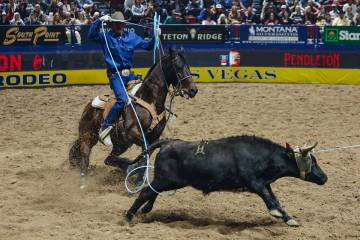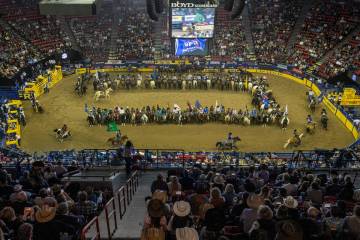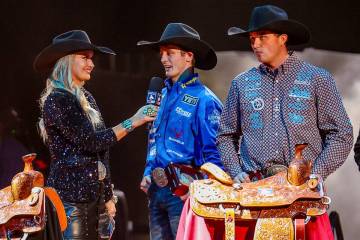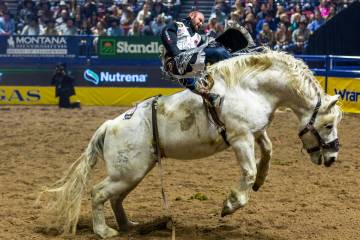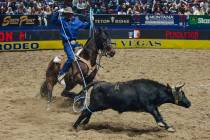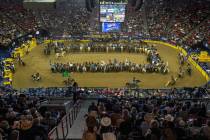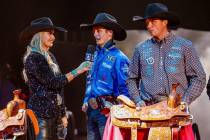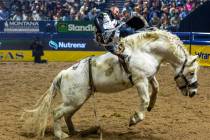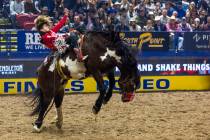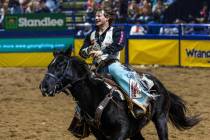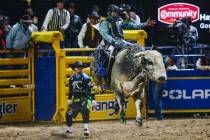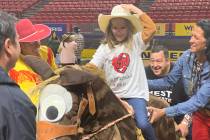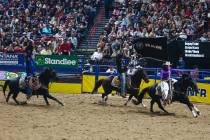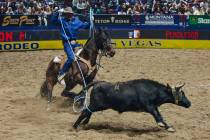Split-second decisions, countless variables all in day’s work for rodeo judges
French Wake lunges out of the chute, carrying Tom McFarland's body, but also his hopes and dreams.
The horse springs into the air and drops to the ground, its body contorted in ways that would make a Cirque du Soleil dancer cringe. But McFarland holds on. More than that, he excels.
And 17,000-plus at the National Finals Rodeo at the Thomas & Mack Center serenade the cowboy with a chorus of cheers.
He salutes them back, a tip of the Resistol, his face lighting up.
But for the four bareback-riding judges in the arena, McFarland has no face. He's but a ghost, a reminder that, on the dirt, there are no friendships, there is no history.
"It's hard not to get familiar with these guys -- judges see these guys at every rodeo they go to. But we say, 'No names, no faces,' " said Tommy Keith, supervisor of officials for the Professional Rodeo Cowboys Association. "That's a key thing. We consider that prejudging, and that's the cardinal sin for us.
"Even the best horse can have a bad day, even the best rider can have a bad day."
And Keith knows.
You would think in three decades of rodeo, he would have seen it all. Every possible twist, every possible turn, every buck and every drop.
But he said that at every rodeo, in every judging seminar, he has learned something new. An animal will do something different, a contestant will react in a new way; in the end, it will have to be a judgment call.
Only in roughstock judging, the animals get scored, too.
That's roughly the equivalent of a gymnast scoring a perfect 10 -- but only if the balance beam is a good one.
And at the NFR, you better get a good one.
"We work really hard to set it as even as we can, but there's still gonna be a top and a bottom of animals," PRCA contestant director Kelly Wardell said. "You try to put 15 animals together that are all the same, and it's tough."
Try telling that to the cowboys.
Every rider has thanked his lucky stars for a good draw, a ride atop a Grated Coconut or a Miss Congeniality. He has cursed those same stars for a bad draw.
But that's tame compared to some of the anger directed at judges. The animals have it easy -- they can't argue back.
"I've been through times when I disagree with (judges) and didn't take it the right way," bareback rider Bobby Mote said. "But worrying about it doesn't do anything but drag you down. This is our livelihood -- this decides whether we can pay the mortgage or feed our family -- but at the same time, you have to let it roll off your back.
"It doesn't do any good to get mad, I know that. I've tried it."
Wardell, a longtime bareback rider and official, said that frustration, that "us versus them" attitude, is hard to ignore. But it goes away with age, as you grow to know the sport and the judges.
"If you let yourself get that attitude, it can really hurt you," Wardell said. "I had it happen early in my career. I'd get down on the judges or down on the draw. It took me a long time ... some cowboys don't ever get over it.
"And I'll tell you, they don't end up here at the NFR."
Once they're here, it starts all over again.
Every last move is critiqued: the spur-out, the free arm, the left leg, the right leg -- 16 criteria in all, 25 possible points. A rider might have a 23-point ride on a 17-point horse, or a 24 with his left leg and a 16 with his right.
And once that score is registered on a judge's keypad, it's over -- perfect call or not.
"I don't think I've ever had a perfect rodeo," said Larry Davis, who started judging for the PRCA in 1983. "You always wish you might've marked an extra point for somebody.
"But that's the thing: Once you put your score in, you can't ever go back."
If Wardell had his wishes, that might not be so true.
Wardell longs for an instant replay system, one that the Professional Bull Riders tour has adopted. Like the NFL or NBA, Wardell only hopes for select aspects to be reviewed, such as the spur-out rule, which maintains that a rider must be in contact with a horse out of the chute when its legs touch the ground after the first move.
Wardell has said he has seen riders get mistakenly disqualified and the opposite -- an 84-point ride without a spur-out.
But for now, it's a judgment call.
It's four men determining the fate of one man and one horse.
"In baseball, in football, they have a clear set of rules," Wardell said. "They go through hours and hours of training to see one exact thing. In rodeo, you've got eight seconds to watch the quality of the horse and the cowboy. It's a very, very difficult job, just trying to see the whole picture."
Sometimes, it can get cloudy.
But this is how it is, how it always has been and probably how it always will be.
Is it fair? Is it the best way to do it?
Well, who's to judge?
Contact reporter Jon Gold at jgold@ reviewjournal.com.
National Finals RodeoMore Info
Slideshow 49th ANNUAL NFR TODAY • 10 a.m.-5 p.m. -- NFR Cowboy Christmas Gift Show, Las Vegas Convention Center, free • 5:45 p.m. -- National Finals Rodeo, fourth go-round, Thomas & Mack Center • 11 p.m. -- NFR buckle presentations, South Point, free




